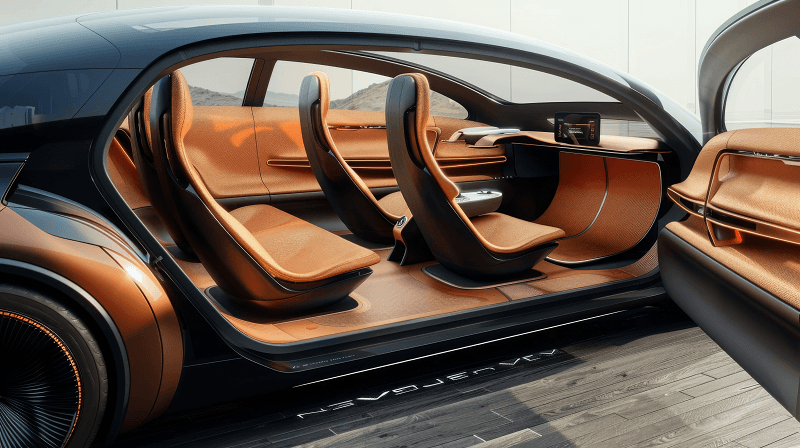
Why the future of automotive design is about sight, smell, touch, sound and responsibility
Waalwijk, the Netherlands, 22 April 2025 – The smell of a new car, the comfort of sitting in your favourite armchair, the vibrancy of cheerful colours — while we often justify our car choices with efficiency, safety or cost, our senses tell the real story. The way a car looks, feels, smells and sounds influences how we experience it – and whether we remember it.
As mobility evolves — from ownership to sharing, combustion engines to EVs, private vehicles to smart, connected transport — the role of our senses only grows. When your vehicle serves as a meeting room, power nap pod, or shared shuttle, every interior detail matters. When technical reliability is a given, it’s the sensory experience that truly sets a vehicle apart.
Martin van den Berg, Global Market Manager Automotive Seat & Trim, Performance Coatings, at Stahl, the global leader in speciality coatings for flexible materials, explains how each sense shapes the mobility of today — and tomorrow.
1. Sight: beauty in cleanliness.
Car interiors are evolving to be brighter, cleaner, and more minimalist. Car interior surface materials exude tranquillity, luxury and spaciousness — but they’re also more prone to visual wear. Scuffs, stains and even dye from a pair of jeans can quickly make a clean seat look worn, leading to growing frustration among car owners. Light-coloured seats tend to be a top annoyance among car owners, simply because they’re so difficult to keep looking fresh!
In shared mobility, the issue is even more pronounced: someone else’s morning coffee, muddy shoes or wet jacket may have been there before you. That’s why modern coatings are designed not just to look great but to stay looking great — resisting stains, dye transfer and daily wear without sacrificing that luxurious light-tone finish.
2. Smell: a case of culture and quality
The perfume your first girlfriend wore, your favourite laundry detergent, an old book — scent is powerfully emotional, yet deeply subjective and culturally dependent. While the scent of fresh leather might evoke luxury in Europe, it may feel overwhelming or artificial elsewhere.
Meanwhile, air quality concerns are pushing the industry to rethink materials. A ‘new car smell’ isn’t enough — interiors should feel clean and safe to breathe. Stahl, for example, develops low-VOC and VOC-free coatings that eliminate harmful emissions without unpleasant odours. The result? Interiors that feel fresh, neutral and trustworthy.
3. Touch: luxury at your fingertips
Touch is one of the most personal aspects of any car interior. You don’t just see the steering wheel or seat — you feel them. Soft, matte surfaces suggest comfort and calm, while cool textures signal control and precision. The way materials feel plays a big role in how appealing a car is, which is why designers are paying more attention to texture and touch.
At Stahl, we develop smooth matte coatings that stay pleasant to the touch — even in extreme temperatures. On hot days, they resist stickiness, thanks to bio-based finishes partially made from rapeseed oil instead of crude oil components. When done right, a driver doesn’t just think a seat feels premium — they instinctively know it.
4. Sound: silence is the new standard
Simon and Garfunkel were onto something: as engines get quieter, other sounds get louder. A light rattle from a plastic panel, a subtle squeak when turning the wheel, a high-pitched rub from the seatbelt buckle. Where once they faded into engine noise, now they define whether a vehicle feels refined or cheap.
This is why sound-dampening materials and anti-squeak finishes are becoming standard, not just in luxury cars but across the industry. New coating technologies can reduce micro-friction between materials and dampen vibration-induced sounds over time, even with daily use. Because whether you’re commuting, working or napping, acoustic comfort matters.
5. Sense of responsibility: do good, feel good
While not a traditional sense, responsibility taps into something deeply emotional: the need to make better choices. Consumers are more aware than ever of their environmental impact — and the automotive sector is under pressure to respond. That response is now increasingly found inside the vehicle.
From recycled fabrics to bio-based coatings and finishes, interior surfaces are evolving to reduce emissions, limit waste and rely less on petroleum-based resources. Many of these innovations use plant-derived materials, such as oils or starches, and meet the highest regulatory standards without compromising on performance. Sustainable design no longer means sacrificing look or feel. Instead, it offers a new kind of luxury — one rooted in transparency, responsibility and long-term value.
At Stahl, we’re all in: smarter surfaces, more versatile interiors, more durable finishes and more sustainable choices. The future feels, looks, smells and sounds good, it’s also more responsible — and we’re down for the ride!
Read Stahl’s White Paper in full here